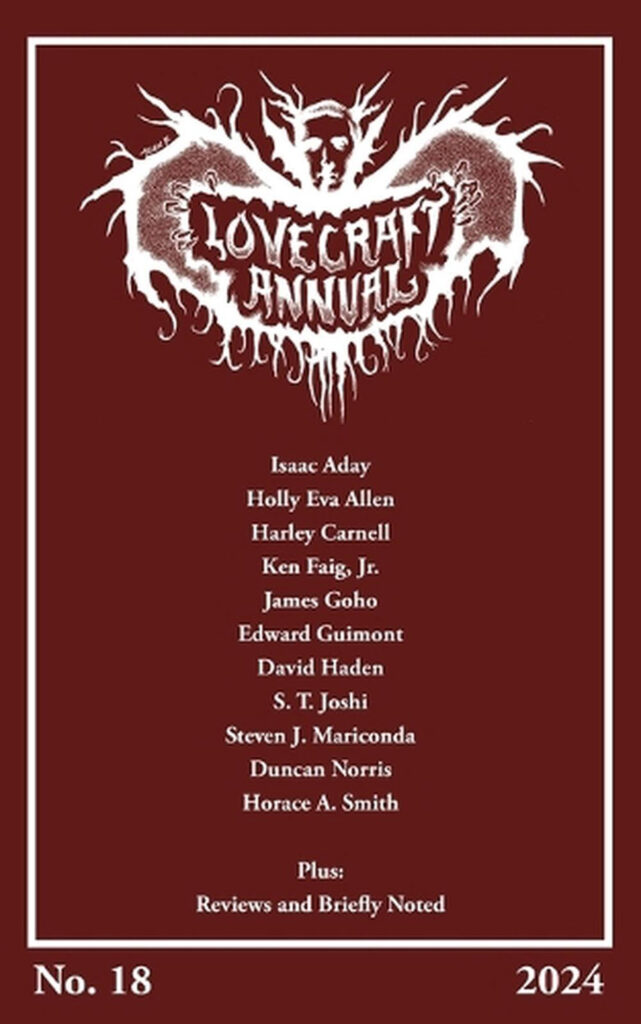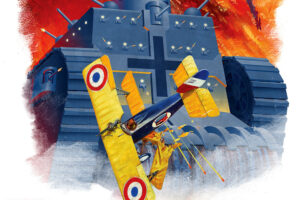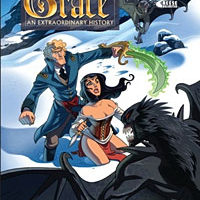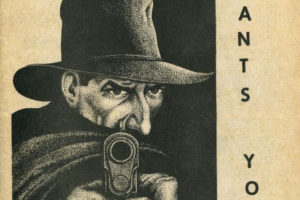 Lovecraft Annual has been published since 2007 for a total of 18 issues so far. Each one comes in at about 200 pages or more with under a dozen articles plus reviews in a 5- by 8-inch size. So far I only have the first two and the most recent three.
Lovecraft Annual has been published since 2007 for a total of 18 issues so far. Each one comes in at about 200 pages or more with under a dozen articles plus reviews in a 5- by 8-inch size. So far I only have the first two and the most recent three.
I won’t go over every article in these, but only those I found most interesting. You can get a full listing of articles at Hippocampus’ website. For me, I never set out to read every article. I’ll pick up an issue, read one or two, and come back later. But I find that many articles here interest me and I enjoy them, so the fact that some do not does not bother me. I find these overall interesting and not dull and boring “academic” papers.
Lovecraft Annual #1 (2007) is 160 pages with nine articles.
From Darrell Schweitzer is “Lovecraft Read This,” which looks at a lost-race story from Argosy that he is pretty certain Lovecraft read and may have influenced him. This work is The City of the Unseen from James Francis Dwyer, but which hasn’t been reprinted for good or bad. This appeared in the December 1913 issue.
We get an interesting item from the nephew of Sonia H. Greene, who was briefly Lovecraft’s wife. Here he provides his personal remembrance of her.
We get a collection of letters from Lovecraft to Lee McBride White in “Letters to Lee McBride White, H.P. Lovecraft.” White was a young man in Alabama who discovered Lovecraft and started a short correspondence with him. These have since been included in the Hippocampus volume H.P. Lovecraft: Letters to J. Vernon Shea, Carl F. Strauch, and Lee McBride White.
“‘They Have Conquered Dream’: A. Merritt’s ‘The Face in the Abyss’ and H.P. Lovecraft’s ‘The Mound'” is a short article by Peter Levi on the influences of A. Merritt on HPL, here using Merritt’s “The Face in the Abyss” and HPL’s “The Mound.” There are other Merritt works that show an influence from Lovecraft.
The impact of Lovecraft on author Thomas Ligotti is the subject of two different articles. I’m not really familiar with his work, but found them an enjoyable read.
Lovecraft Annual #2 (2008) is over 200 pages with seven articles along with reviews.
Astronomy was long a topic of interest for Lovecraft, with one of the Collected Essays volume devoted to science (from Hippocampus), much of it astronomy. In this long article that takes up almost a third of the issue, “Dispatches From the Providence Observatory: Astronomical Motifs and Sources in the Writings of H.P. Lovecraft” is exactly what it says. It gives a detailed examination of astronomy in his works.
James Goho‘s article, “The Sickness unto Death in H.P. Lovecraft’s ‘The Hound'” starts off with the pearl-clutching when Lovecraft was included in the Library of America before moving on to Lovecraft’s “The Hound,” a story that is considered to be a self-parody. But he uses this work as a defense as it’s one that is often criticized.
Lovecraft’s “The Rats in the Walls” is one of his few stories set outside New England. Robert H. Waugh‘s article “‘The Rats in the Walls,’ the Rats in the Trenches” has a different take on the story, saying that it should be seen as a World War I-based tale, with allusions to rats in the trenches of the war.
In the early 20th century, there were various claims, all spurious, of archaeological discoveries in the American Southwest of various “lost” colonies. In “H.P. Lovecraft and the Archaeology of ‘Roman’ Arizona” by Marc A. Beherec, we look at the potential influence of a claimed lost Roman colony in Arizona. As someone with an interest in such claims, I found this very interesting.
Lovecraft Annual #16 (2022) is 260 pages with 11 articles.
Our first article is “A Tale of Two Providences: Topographical Realism in ‘The Haunter of the Dark'” by Dylan Henderson, which takes a look at how realistic the description of Providence in that story was to the real one. And considering Lovecraft lived there, that makes sense.
David Haden provides an article on “Uncle Eddy,” a man who ran the largest bookstore in Providence, was Lovecraft’s favorite bookseller, and whose wife wrote letters to various pulp magazines about Lovecraft.
While I’ve watched Star Trek, the original series, and read about the few elements that people point out about possible Lovecraft influence, “The Ripple Effect: Star Trek and the Lovecraft Mythos” by Cecelia Hopkins-Drewer delves more deeply into it. Not only pointing out more story elements from several episodes but also into who might have been influenced.
Glocester’s Dark Swamp had an influence on Lovecraft. He even went on a journey with C.M Eddy Jr. to visit it, which inspired both of them in some stories. In Stephen Olbrys Gencarella‘s “Lovecraft and the Folklore of Glocester’s Dark Swamp,” he looks into the question of whether local legends and folklore had an influence on Lovecraft. He delves into their journey there, their writings from it, and what lore existed around it.
I think most Lovecraft fans are aware of the story he ghost-wrote for Houdini. I’m not sure how many are aware that he and C.M. Eddy Jr. were working together on a further work for Houdini. In recent years, handwritten and typescript versions have appeared and been researched. César Guarde-Paz‘s article “The Authorship of the Cancer of Superstition and Lovecraft’s Late Readings on Folklore” looks at the question of authorship of the work and the sources that Lovecraft made us of.
Andrew Paul Wood provides “A Note on Nodens in Lovecraft’s Mythos,” which examines this character and its origin in Lovecraft’s work, though it seems August Derleth made larger use of him.
The final article, “Painting in Word Shadows: The Role of the Hidden and Unknown to the Reader in Lovecraft” by Duncan Norris looks at that unique element in Lovecraft’s writing that fans love, detractors hate, and followers never quite capture: his use of the “unknowable.” This uses several examples from his works.
Lovecraft Annual #17 (2023) is over 240 pages with a dozen articles.
Edith Miniter (1867-1934) was an amateur author who lived in Massachusetts and whom Lovecraft visited once, though she did not write weird fiction. She is more a New England regionalist. Sadly, she has been largely overlooked in her time. We get her work “Falco Ossifracus” (1921), which is a satire of Lovecraft’s style of writing. This is followed by a piece by Ken Faig Jr. on this work and its inspirations.
Hippocampus Press has two volumes of her works for those interested. I would have liked to have had a bit more about her, as there isn’t even a Wikipedia article on her.
Duncan Norris provides two articles. The first “The Pop Cultural Lovecraft: Two Snapshots” looks at Lovecraft’s influence on pop culture. The first snapshot looks at a group of 10 Lovecraftian movies. The other is with clothing, like t-shirts with various slogans. The second article, “Indecipherable Manuscripts, Old Families, and Bloody Murder” has a strange title, unless you note the subtitle, which explains these are the elements that start many Lovecraft tales. It starts with the use of the Voynich Manuscript for the similar use of documents. Old families, especially corrupted ones, are also common.
The short article “‘The Dunwich Horror’ and Ghostbusters” by Ron L. Johnson II looks at the inspiration of “The Dunwich Horror” on the Ghostbusters movie. I wouldn’t have thought this, but the links given are good.
As the title implies, Andrew Paul Wood’s “A Kind of Sophisticated Astarte: On the Nature of Shub-Niggurath” is a fairly exhaustive examination of the title character, delving into what Lovecraft and others wrote as well as what might have been Lovecraft’s influences in creation “her.” His second article is on Lovecraft’s “Pickman’s Model.”
We don’t think of Lovecraft as being some kind of futurist, but in Edward Guimont‘s article “H.P. Lovecraft, Jules Verne, and the Future City,” we look at an obscure Lovecraft poem that presents a possible future, “Providence in 2000AD,” which is compared and contrasts with some of Jules Verne‘s works that also present a future world because he feels it was Verne that inspired this and some other Lovecraft works.
“How to Read Lovecraft” is a semi-regular column by Steven J. Mariconda. Past columns appeared in #12 through 15. This issue has #6: “Is Lovecraft Amusing? Or, You’ve Got to Be Kidding Me?” As the title indicates, it looks at the use of humor by Lovecraft, which is an element I wasn’t too aware of. Probably because his humor is pretty subtle.
Other articles include Dylan Henderson’s “The Disgusting Thing on the Doorstep”; Francesco Borri‘s “The Year of the Red Moon: ‘Out of the Æons,’ Revisions, and Deep History”; and James Goho’s “The Sound out of the Unknown.”
 Lovecraft Annual #18 (2024) is almost 240 pages with a dozen articles.
Lovecraft Annual #18 (2024) is almost 240 pages with a dozen articles.
Holly Eva Allen addresses sexual issues in “The Thing on the Doorstep.” To be honest, like others, find this a tiresome theme. Isaac Aday analyzes “The Colour Out of Space” from the perspective of sociologist Max Weber. From Edward Guimont, we get a study of “The Call of Cthulhu” through a “colonialist lens.” I was leery about this one, but overall found it a good article. James Goho examines the narrative methods of “The Mound.” Norris and Harley Carnell trace Lovecraft’s influence on later works, including Robert Bloch’s Psycho. Hopefully, most are aware that Bloch was a correspondent of Lovecraft who encouraged Bloch, even using a character based on him in one of his stories.
David Haden takes a look at the eateries frequented by Lovecraft during his time in New York, with several pictures and some maps. I actually found this much more interesting than I expected. Once you read the article, you’ll understand the title “Eating Anarchist Spaghetti With Lovecraft.”
Ken Faig Jr., who has been writing on various friends and relatives of Lovecraft, most collected into two books, takes a look at his first cousins. So might we see a third volume?
S.T. Joshi gives an update on the complete Lovecraft letters project, as the final volume has been finished and will soon be in print with letters with Frank Belknap Long. We will have over 20 volumes, mainly from Hippocampus Press, of all of his extant letters, which makes the prior five-volume set from Arkham House useless. I will need to do a longer post on them, though I only have a few volumes myself.
Duncan Norris has two pieces in this work. The first probes the use of small details in fostering realism in Lovecraft’s tales. He goes over many stories with this fascinating article. His second is another article on Lovecraftian influences on Rick and Morty, a fairly mature animated series on Cartoon Network. This time he looks at the Rick and Morty vs. Cthulhu comic series that came out recently.
Horace A. Smith, who has put out a book through Hippocampus on Lovecraft’s interest in astronomy (When the Stars Are Right: H.P. Lovecraft and Astronomy), delves into Lovecraft’s interest in a particular comet.
We get number seven in the “How to Read Lovecraft” column from Steven J. Mariconda. This one gives us an interview with Peter Cannon, who has written works about Lovecraft, both fiction and non-fiction.
So this is what we have so far. As all issues are done via print-on-demand, there are no worries about issues being unavailable. I plan on slowly getting the other issues. New issues come out in the Fall, so I look forward to the next issue later this year.




Add Comment